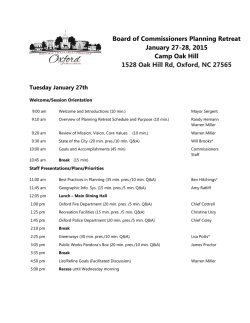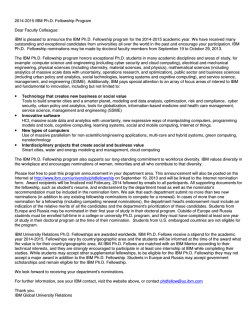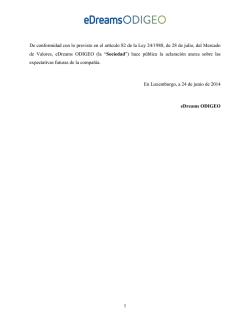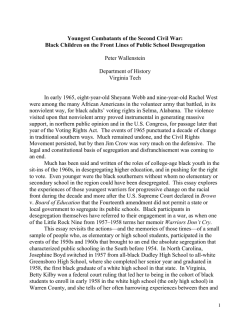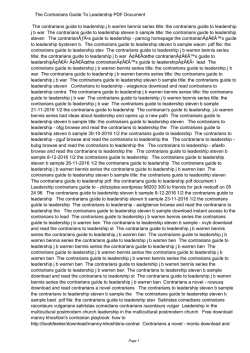
Case Study on Investment Filters (Warren Buffett )
Case Study on Investment Filters (Warren Buffett) Darden MBA (McIntyre) Value Investing Conference Video #5 November 11, 2008 Presentation by Alice Shroeder, Author of Snowball* (see Appendix on page__) There had to be a Holy Grail with Warren Buffett, because I (Alice Shroeder) had heard from some so many investors a little bit of irritation—might not be the right word--because Warren always says it is very simple. There are just a few simple principles, and if you were only working with a smaller amount of money he could earn 50% returns a year. Well, I have had a lot of people say to me, “Well, I am working with a smaller amount of money, if it is really that simple, why am I not earning 50% returns a year? So the question is...is it just because Warren Buffett is a genius, is it just that we are all dumb, or is the truth somewhere in between? And I think the truth is somewhere in between. I was sure somewhere hiding in his office was the Holy Grail. In fact, though WEB is brilliant, and he is different from everybody else, there is something more to it because he does have a way of making the difficult look easy, and he also has a hard time understanding or perhaps even admitting how hard he works. It is sort of like asking a fish to describe water. And there are some concepts (habits) that are so ingrained, so embedded in him that he doesn’t even understand them himself. They have been there for so long. For example, take the rule he follows about asset turnover. Quote: “No real investor likes to trade. It is never pleasant to depart forever from an old friend.” That probably sounds something like what Warren would say or Ben Graham would say, but it is not. That is from a book called Bond Salesmanship. Bond salesmanship - Hardcover (Jan 1, 1924) by William W Townsend, which Warren read when he was seven years old, and he asked for this book for Christmas by the way. Whenever he reads a book as a child he usually read the books 4 or 5 times and memorized them. So some of these ideas have been so ingrained in him from an early age that it is hard to know whether they are innate or whether he invented them or whether he picked them up from sources like this when he was very young. But he got a lot of reinforcement from a very early age. Now for those of us who didn’t, the question is what in Warren’s papers and mental files will help us be better investors even though we can’t be the next Warren Buffett. I did find some things but let’s start reviewing four concepts that you hear over and over….that are the basics of value investing and they are: 1.) Intrinsic value and especially applying the Phil Fisher qualitative investing concepts to intrinsic value. Common Stocks and Uncommon Profits and Other Writings (Wiley Investment Classics) (Paperback) by Philip A. Fisher (Author), Ken Fisher (Introduction) "This is among the most beloved investment books of all times, among the bestselling of classic investment books, and now forty-five years old..." 2.) Ignoring the Mr. Market Manic Depressive Behavior. 3.) Performance drag of too much turnover and too much diversification. www.csinvesting.wordpress.com Page 1 4.) Ben Graham margin of safety concept which arguably is the most important ever developed in investing. All of these are very important but when I (Alice Schroeder) studied and spent so much time with Warren Buffett, what I actually saw he invests and applies his investing concepts but what he actually does is a little but different, so what I would like to do is take you on a bit of a journey using a specific investment that he made. I did not write about it in the book because it was cut for length. It illustrates principles that I talk about in the book, but it shows how Warren thinks. The piece is a little bit too technical for the general reader to be put into the Snowball. But also, as an overview, so much of Warren’s success has come from training himself in good habits—and it is worth saying that because—he always says that the chains of habit are too light to be felt until they are too heavy to be broken. He is talking about bad habits, but it was Aristotle who said we are what we repeatedly do. Excellence then, is not an act, but a habit. Warren is the creature of habit. He is the ultimate creature of habit. His first habit was hard work. I write over and over again in the book (Snowball) about the fact that he was at the Securities and Exchange Commission (“SEC”) digging up documents before they were electronically available. He was down at the state insurance commission in the bowels of the basement looking up filings, He was knocking on the doors of businesses talking to the managements when they were saying you are a pest go away. He was sending Dan Mohnan around the state to buy up shares of National American Insurance. He was always thinking and working. And a lot of his work was not obvious; it was not repetitive or routine. He was always’ thinking, “What more can I do? Especially what more can I do to get an edge on the other guy.” Now importantly, I know a lot of people will point out there are a lot of thing Warren did that you can’t do these days because either the information is so available electronically that everybody has it or it is insider information that would be illegal to use. But the principal of the hard work did is still the same. I was talking to someone earlier and we were sort of talking in awe of how hard Warren Buffett worked and the fact that most people would work that obsessively. But for those few who do work obsessively, there is a reward. The main thing he worked at was learning. The guy is—as Charlie Munger puts it—a learning machine. And his learning has been cumulative. It has been a tremendous advantage to him in business. He has this mental file cabinet that has been built up starting when he was a very small child sitting in his stock broker father’s office reading the financial statements and descriptions of thousands of businesses and dozens of industries over and over and over. This is really why when people call him with a business proposition he can say yes or no instantly because he has that file cabinet in his mind that is so deep. It does help to have a photographic or near photographic memory which he has, but at the same time, that learning is what makes him Warren Buffett. The learning was cumulative. I think that is worth mentioning too. He has chosen a profession to learn in a field where the knowledge adds and builds on top of each other. And so I think we can all be better investors for knowing that. Well, up to this point there is no great mystery to it for everyone who has read Snowball how hard he has worked and how much learning he has done. But there are three other factors to his success that www.csinvesting.wordpress.com Page 2 I would like to talk about and focus a lit bit differently the normal way he explains investing…….and that is: Handicapping, compounding and the margin of safety. These are three concepts that work together. He uses them in a slightly different way than he would think of describing them publicly. They are all discussed in the book. I would now like to take you through a little case study. Case Study: Mid-Continent Tab Card Company. This was a private investment that he did in his personal portfolio. It shows you how I saw him invest based on his personal files and what he actually does. Then I will update that to the present day. This company was an outgrowth of IBM and, as you all know, Warren did not use computers in the 1950s but he was very aware of them. IBM was the only computer company of any size or importance at that time. And Warren’s Aunt Katie and her Uncle Fred had decided to invest in Control Data which was a start up company that was going to compete with IBM. Katie’s brother who was Bill Norris was founding Control Data because he wanted to create a business. He thought IBM was slow and bureaucratic. And Warren told Katie and Fred not to invest in Control Data. He said to them, “Don’t do it.” Who needs another computer company? Those were his famous last words. They invested in Control Data anyway and they made a huge amount of money. And what was notable about this incident was that Warren told them not to invest because he actually knew a lot about IBM by studying IBM. He had been studying IBM since 1952 it had been in court embroiled in an anti-trust case for being a monopoly. Warren studied its financials and even though by then he had already declared IBM outside his circle of competence. (It is interesting that he would study a company outside his circle of competence. Perhaps, he wished to be informed about an important company. Like studying Google today to understand its effect on the Media industry?) He felt that even though IBM might have to broken up one day, that its monopoly was so overwhelming--and, of course, he likes monopoly businesses--that to compete with it would be futile. So what happened was that IBM did actually settle with the Justice Department. And as part of that settlement it was required to divest of a business making tab cards. What is a tab card? Before computer were digital, computers read off of punch cards. They were called Marke-Sense Cards, and these were big decks of cards with holes punched in them and they would be stuck in the computer, and they would be read mechanically through the computer. Definition: A punch card or punched card (or punchcard or Hollerith card or IBM card), is a piece of stiff paper that contains digital information represented by the presence or absence of holes in predefined positions. Now almost an obsolete recording medium, punched cards were widely used throughout the 19th century for controlling textile looms and in the late 19th and early 20th century for operating fairground organs and related instruments. It was used through the 20th century in unit record machines for input, processing, and data storage. Early digital computers used punched cards as the primary medium for input of both computer programs and data, with offline data entry on key punch machines. Some voting machines use punched cards. This company was formed because IBM had to divest of this business; it was an incredibly profitable business. In fact, because these cards were trivial because of the mainframe computers that IBM sold, it marked the cards up to earn a 50% profit margin. This was IBM’s most profitable business. www.csinvesting.wordpress.com Page 3 So when Wayne Ace and Warren Cleary who were two friends of Warren’s saw that IBM was going to have to divest in this business, and they thought we are going to buy a Carroll Press which was a press that makes these cards. And we are going to compete with IBM because we are based in the Mid West, we can ship faster. We can provide better service. And they went to Warren and they said, “Should we invest in this company and would you come in with us? And Warren said, “No.” Well, why did he say no? He didn’t say no because it was the technology company. He said no because he went through the first step in his investing process. This is where I think what he does is very automatic but it isn’t well understood. He acted like a horse handicapper. The first stop in Warren’s investing process is always to say, “What are the odds that this business could be subject to any type of catastrophe risk—that could make it (the business) fail? And if there is any chance that any significant part of his capital would be subject to catastrophe risk, he just stops thinking. NO. He just won’t go there. It is backwards the way most people think because most people find an interesting idea and figure out the math, they look at the financials, they do a project and then at the end, the ask, “What could go wrong.” Warren starts with what could go wrong and here he thought that a start-up business competing with IBM can fail. Nope, pass, sorry. And he didn’t think anymore about it. But Wayne and Cleary went ahead anyway and within a year they were printing 35 million tab cards a month. At that point, they knew they had to buy more Carroll Presses so they came back to Warren and said, we need money— would you like to come in? So now, Warren is interested because the catastrophe risk is gone. They are competing successfully against IBM. So he asks them the numbers, and they explain to him that they are turning their capital over 7 times a year. A Carroll Press costs $78,000 dollars and every time they run a set of cards through and turn their capital over, they are making over $11,000. So basically their gross profit on a press (7 x $11,000 = $77,000) is enough to buy another printing press. At this point Warren is very interested because their net profit margins are 40%. It is one of the most profitable businesses he has ever had the opportunity to invest in. Notably people are now bringing Warren special deals to invest in—it is 1959. He has been in business for 2.5 years running the partnership. Why are they doing that? It is not because he is a great stock picker. They don’t know that. He hasn’t yet made that record. It is because he knows so much about business, and he started so early he has a lot of money. So this is something interesting about Warren Buffett—people were bringing him special deals like they are today with Goldman Sachs and GE. He decided to come in and invest in the Mid-Continent Tab Company but, interestingly, he did not take Wayne and John’s word for it because the numbers they gave him were very enticing. But, again, he went through and he acted like a horse handicapper. Now here is another point of departure. Everyone that I know or knew as an analyst would have created a model for this company and projected out its earnings or looked at its return on investment in the future. Warren didn’t do that. In going through hundreds of his files, I never saw anything that looked like a model. What he did is he did what you would do with a horse….he figured out the one or two factors that determined the success of the investment. In this case, it was the cost advantage that had to continue for the investment to work. And then he took all the historical data, quarter by quarter for every single plant and he obtained similar information as best he could from every competitor they www.csinvesting.wordpress.com Page 4 had, and he filled several pages with little hen scratches with all this information and then he studied that information. Then he made a yes/no decision. He looked at—they were getting 36% margins, they were growing over 70% a year on a $1 million of sales—so those were the historical numbers. He looked them in great detail like a horse handicapper would studying the races and then he said to himself, “I want a 15% return on $2 million of sales and said, Yes, I can get that.” Then he came in as an investor. OK, what he did was he incorporated his whole earnings model and compounding (discounted cash flow or DCF) into that one sentence. He wanted 15% on $2 million of sales (a doubling from $1 million current sales). Why does he chose 15%? Warren is not greedy, he always wants 15% day one return on investment, and then it compounds from there. That is all he has ever wanted and he is happy with that. …You are not laughing, what’s wrong? (Laughs) It is a very simple thing, nothing fancy about it. And that is another important lesson because he is a very simple guy. He doesn’t do any DCF models or any thing like that. He has said for decades, “I want a 15% day one return on my capital and I want it to grow from there-ta da! The $2 million of sales was pretty simple too. It had a million in sales already and it was growing at 70% so there was a big margin of safety built into those numbers. It had a 36% profit margin—he said I would take half that or 18%. And he ended up putting in $60,000 of his personal, non-partnership money which was 20% of his net worth at that time. He got 16% of the company’s stock plus some subordinated notes. And the way he thought about it was really simple. It was a one step decision. He looked at historical data and he had this generic return that he wants on everything. It was a very easy decision for him. He relied totally on historical figures with no projections. I think that is a really interesting way to look at it because I saw him do it over and over again in different investments. So what happened? Well? The company changed its name to Data Documents, and he owned it for 18 years. And he ended up putting another $1 million dollars into it over that time. It was bought out in 1979 by Dictograph, and he earned 33% compounded return over the time period he owned the investment (18 years CAGR—excluding additional capital $60,000 would compound to $1.18 million) so it was not too bad. That was typical. I gave you this example because it was the other time besides GEICO that he got a Phil Fisher-type growth company at a Ben Graham like price. It was the most vivid example that I found, but it was a private investment and there is not a lot of public information about it available. So, fast forwarding a little bit, why he thinks so much about catastrophe risk? Firestone’s law where he said, “Chicken Little only had to be right once.” And that is always the first thing that Warren thinks about. So why is Berkshire Hathaway today not dealing with some of the problems that other people are? It is because Warren passed on investing on a lot of things that he could have because the first question he always asks is, “What is the catastrophe risk?” And if the business or investment has catastrophe risk, he just says no. You could probably get into an interesting discussion on stocks like AIG. That was a stock I was wrong on that for a long time until I finally turned around. He never invested in AIG because of the Catastrophe Risk. People brought him Bear Stearns or Leman Brothers, and he turned them down. He saved himself a lot of trouble, time and energy this way. If you ask yourself the catastrophe risk question first before all the historical data, you will save yourself a lot of time and tears. www.csinvesting.wordpress.com Page 5 Because Warren is focused on efficiency, that is why he does that, and he is also very good at being realistic. And once he figures that something has the catastrophe (“Cat”) risk, he passes or never tries to change himself out of making that decision. So today when you think about what is happening now (November 2008) like deals going on right now like Citigroup, Goldman Sachs people are still bringing him special deals that no one else can get, and he still is making sure that they do not have the cat risk as best he can. He is making a bet on management and his reputation as an investor—to some extent--can help these deals. They are giving him 10% guaranteed return—that is the minimum--on these deals. He still wants the 15%. At times, he has taken less and lowered his standards and he usually has been sorry when he has. When it comes to the market as a whole, he uses somewhat the same technique. He recently said that he finds the stock market attractive now. In his 1999 Sun Valley speech he talked about investing in the market when the stock market’s value was between 70% and 80% of GDP. It is somewhat the same method because at that level, obviously the stock market is not going to zero and he has a huge margin of safety built into that, just as the 15% return and $2 million included a huge margin of safety given how fast Mid Continental Tab company was actually growing and the margins it was actually getting. And so he has put his margin of safety into return expectations. He is using only historical data and he uses years and years of that data to arrive at the conclusion that, again, probabilities—he is handicapping—that it is the right price to buy. He doesn’t care if it (the market) goes up and down in price for the next two or three years. He just knows that at this price, he will do well over time. I do think that it is really amazing that three weeks later there are pundits out there that the greatest living investor of our time and possibly ever is wrong for having made these investments and having predicted that the stock market is a buy right now. It is really ironic and interesting that somebody who has never been wrong in making a prediction and that the people who have been wrong in the past making predictions once again saying he is wrong. Since we are talking about this handicapping concept, this is just a little quote from the Intelligent Investor that the margin of safety is always dependent upon the price paid. If, as we suggest, the average price level for most growth stocks is too high to provide a margin of safety for the buyer, then this simple technique of diversified buying may not work satisfactorily. That obviously applies o the market as a whole. One thing that I think Warren Buffett should get a lot of credit for and a round of applause for is that he never, ever advocated dollar-cost averaging because it is wrong. The concept has led many people off a cliff. It is not right to buy the market at any price. And you have never heard him suggest that anyone should do it. I think he should get a lot of credit for that. In the end, thank you for listening to this story, and I hope it gives you a little insight into how he thinks. It is also indefinable. There are certain things about him that will always be a mystery and never be explainable. And there is one thing you can emulate but only if it comes from the right place inside you. It has been said—and this came early to Warren--that the only person who is really qualified to advise you as to what you can do is yourself. He (Buffett) calls this your inner scorecard. You know yourself better than anyone. You and you alone know how determined you are to make something a success of any undertaking. And in the last analysis, 90% of being successful in business is that indefinable thing , which for lack of a better name we call GUTS. That quote is from a book called a 1000 ways to make a $1,000. Thank you. www.csinvesting.wordpress.com Page 6 *McIntire and Darden Co-Host Value Investing Conference November 11, 2008 — What's the best asset to own now? Will today's financial turmoil force hedge funds out of the market, or fundamentally alter the processes by which hedge fund managers make investment decisions? Will Warren Buffett serve as Secretary of the Treasury in the Obama administration? These were just a few of the questions pondered by a group of 25 investment professionals during two days of presentations and panel discussions at the University of Virginia's inaugural "Value Investing Conference," hosted by the McIntire School of Commerce and the Darden School of Business. The free, public conference was held Thursday and Friday at Charlottesville's Paramount Theater and the Darden School's Abbott Center Auditorium. "The mission of the Value Investing Conference is to assemble the investing public, professional investors, scholars and students in the field of value investing for the purpose of highlighting and disseminating best practices, honoring best practitioners and revealing new trends and developments in the field," said Darden Dean Robert Bruner, noting that he expects the conference to become an annual event. "Value investing," an investment paradigm pioneered by Benjamin Graham in the late 1920s — and perfected by Charlie Munger and Buffett over the last half-century — involves buying securities whose shares appear to be underpriced according to the metrics of various methods of fundamental analysis. The conference was dominated by discussion of the current financial crisis, and opened with a panel discussion of the crisis's implications for investors, value investing and the hedge fund industry. Commenting on current conditions, the six panelists — Christopher Brightman, chief executive officer of the University of Virginia Investment Management Company, or UVIMCO; Rich Evans, assistant professor of business administration at Darden; 1985 Mcintire alumnus John Griffin, founder and trustee of Blue Ridge Capital; 1979 Darden alumnus John Macfarlane, chief operating officer of Tudor Investment Corporation; 1964 College graduate and 1968 Darden graduate Dick Mayo, chairman of Mayo Capital Partners; and Ken Shubin Stein, founder of Spencer Capital Management — agreed that the scope, magnitude and complexity of today's situation have created an environment of enormous and unprecedented uncertainty. "We've been running a macroeconomic experiment for the past two decades," Shubin Stein said, "and there are so many variables involved, it's impossible to know what's happening." But Griffin, who stated that he too has "no idea" what is currently going on, argued that by constructing a fundamentally sound portfolio, guided by consistent, sound principles and thorough, rational analysis, crisis can be averted. "You build your ark during sunny days for times like this," Griffin said. Griffin also warned against what he termed "reversion to the mean syndrome" — that is, the tendency to believe — and to bet — on the idea that things will revert to the mean. "There's nothing in life that says that things have to revert to the mean," Griffin said. "The future is uncertain." Nevertheless, experts on other panels sought to examine subjects characterized by somewhat more certainty (at least for the moment), including where value can currently be found around the globe; the www.csinvesting.wordpress.com Page 7 consistently strong relationship between sound management and successful investment; how to find value in under explored asset classes; and the cognitive biases that invariably cause investors to make bad decisions. "Our goal in organizing this conference was not to provide our audience with predictions for the future, but rather to provide them with some insight into to the art of value investing, as practiced by some of today's most successful investors," said conference organizer David C. Smith, associate professor of finance at the McIntire School and director of McIntire's Center for Financial Innovation. "We wanted to demonstrate to our audience that well-allocated capital can act as an engine of prosperity, regardless of economic conditions." The conference's opening night also featured a presentation by Alice Schroeder, author of "The Snowball: Warren Buffett and the Business of Life," currently Amazon.com's best-selling business book and the only authorized biography of the legendary value investor. Schroeder detailed for the audience Buffett's near-photographic memory for financial statements and information, remarkable ability to identify the odds of catastrophic risk in any potential investment, extraordinary work ethic and devilishly simple investment philosophy. (Schroeder also commented, in response to an audience member's question, that Buffett would "definitely not" be interested in serving as the new Secretary of the Treasury.) Conference attendees also heard from Whitney Tilson, winner of the 2008 "Navigator of the Year" Award, given annually to an investment professional who, through his or her gifts of time and capital, has improved society and motivated others to serve. Tilson, the founder and managing partner of T2 Partners LLC, reminded the audience that wealth is uncorrelated with happiness and that real happiness comes from helping others. "Clearly, the inaugural Value Investing Conference was a tremendous success," said McIntire Dean Carl Zeithaml. "We are extremely pleased to host such an outstanding group of investment professionals to discuss topics of such vital interest, timeliness and importance, and we look forward to hosting the Value Investing Conference next year in McIntire's state-of-the-art new home in Rouss & Robertson Halls." To see the full agenda of the Value Investing Conference and to read about conference participants, go to www.darden.edu/vic/. Comments/Thoughts Enormous evidence shows that investors are hopeless at forecasting yet it remains a core part of their investing process. Buffett avoids forecasting the unknown. Also, by simplifying his decision making, Buffett avoids swamping himself with more information and having to make more decisions. As A Review Buffett took three (3) main principles from Benjamin Graham A stock is the right to own a little piece of a business. A stock is worth a certain fraction of what you would be willing to pay for the whole business. Use a Margin of Safety. Investing is built on estimates and uncertainty. A wide margin of safety ensures that the effects of good decisions are not wiped out by errors. The way to advance, above all, is not be retreating. www.csinvesting.wordpress.com Page 8 Mr. Market is your servant, not your master. Graham postulated a moody character called Mr. Market, who offers to buy and sell stocks every day, often at prices that don’t make sense. Mr. Market’s moods should not influence your view of price. However, from time to time he does offer the chance to buy low and sell high. Section: Learning LEARNING PERSPECTIVE Through Financial History (p. 148 – Snowball) Buffett haunted Columbia University’s Library reading old newspapers for hours on end. “I would get these papers from 1929. As he said, “I couldn’t get enough of it. I read everything—not just the business and stock market stories. History is interesting, and there is something about history in a newspaper, just seeing a place, the stories, even the ads, everything. It takes you into a different world, told by somebody who was an eyewitness, and you are really living in that time.” That quote tells you how much Buffett loves to learn about the history of the market. He is enthused, focused and obsessed. If you don’t share the same type of enthusiasm then you may be at a disadvantage. Search Criteria and Filters (see pages 296-297 Snowball) Interestingly during the beginning of the go-go stock market of the 1960 (See the Go-Go Years by John Brooks about the stock market during that era) Buffett did not relax his rules in search of ways to keep the money at work. Instead, he laid out two new restrictions that would make it even harder for him to invest. These personal preferences now became part of the official canon. 1.) We will not go into businesses where technology which is way over my head is crucial to the investment decision. I know about as much about semiconductors or integrated circuits as I do of the mating habits of the chrzaszcz. 2.) (W)e will not seek out activity in investment operation, even if offering splendid profit expectations, where major human problems appear to have a substantial chance of developing. By major human problems he meant layoffs, plant closings and union busineeses that could take a strike. He would tend to avoid “cigar” butts. Keeping an inner scorecard P 682: When asked if it bothered him when people called him a has-been. “Nothing bothers me like that. You can’t do well on investing unless you think independently. And the truth is, you are neither right nor wrong because people agree with you. You are right because your facts and reasoning are right. In the end, that is what counts. A Margin of safety means to allow ample room for error. Graham on diversification and net/nets: Graham knew that a certain number of cigar butts would turn out foul, and though it futile to spend time examining any individual cigar butt’s quality. The law of averages said most of them were good for a puff. He was always thinking in terms of how much companies would be worth dead—what their www.csinvesting.wordpress.com Page 9 assets would be worth if liquidated. Buying at a discount to that value was his margin of safety—his backstop against the percentage that presumably would go bankrupt. As a further backstop, he bought tiny positions in a huge number of stocks-the principle of diversification. Graham’s idea of diversification was extreme; some of his positions were as small as $1,000. Delete/Move passage below…… Think for yourself and Be a Skeptic. The message of the Black Swan is how important that the things everyone rules out can still come to pass. That might be generalized as understanding the importance of skepticism. I define skepticism as not believing what you are told or what everyone considers true. In my opinion, it is one of the most important requirements for successful investing. If you believe the story everyone else believes, then you will do what they do. Usually you will buy at high prices and sell at low prices. You will fall for tales of the Silver Bullett capable of delivering high returns without risk. You will buy what has been doing well and you will sell what has been doing poorly and you will suffer losses in crashes and miss out when things recover from bottoms. In other words, you will be a conformist not a maverick, an overused word these days. A follower, not a contrarian. What it takes behind a balance sheet or the can’t miss story prettied up. Usually it has been doing well making the tale more credible. Only a skeptic can things that sound good and are and those that sound good and aren’t. The best investors, I know, exemplify this trait. It is an absolute necessity. www.csinvesting.wordpress.com Page 10
© Copyright 2025

